Jingyi Liao
Patch-as-Decodable-Token: Towards Unified Multi-Modal Vision Tasks in MLLMs
Oct 02, 2025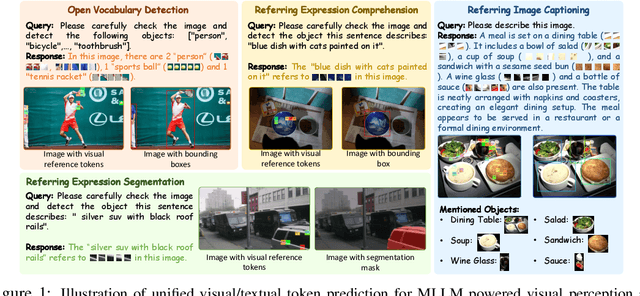
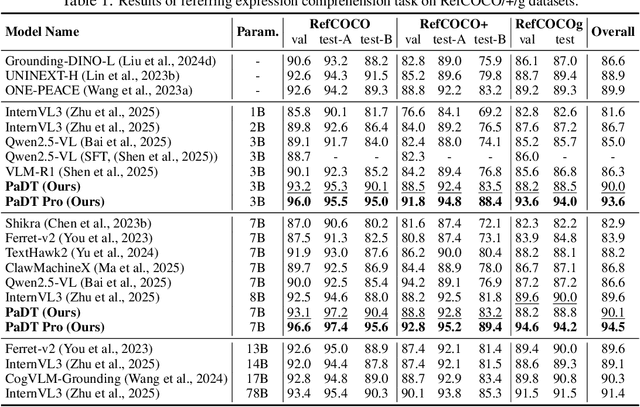
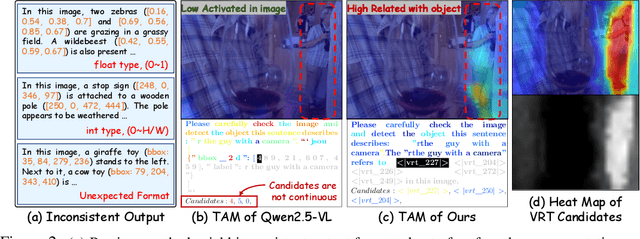
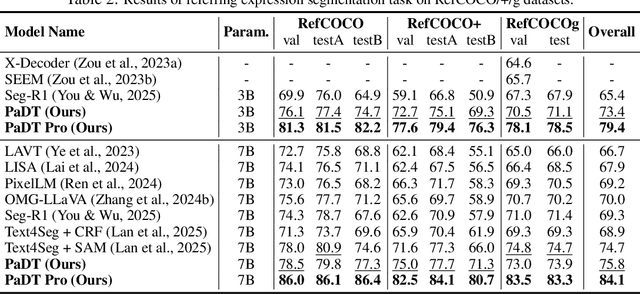
Abstract:Multimodal large language models (MLLMs) have advanced rapidly in recent years. However, existing approaches for vision tasks often rely on indirect representations, such as generating coordinates as text for detection, which limits performance and prevents dense prediction tasks like segmentation. To overcome these challenges, we introduce Patch-as-Decodable Token (PaDT), a unified paradigm that enables MLLMs to directly generate both textual and diverse visual outputs. Central to PaDT are Visual Reference Tokens (VRTs), derived from visual patch embeddings of query images and interleaved seamlessly with LLM's output textual tokens. A lightweight decoder then transforms LLM's outputs into detection, segmentation, and grounding predictions. Unlike prior methods, PaDT processes VRTs independently at each forward pass and dynamically expands the embedding table, thus improving localization and differentiation among similar objects. We further tailor a training strategy for PaDT by randomly selecting VRTs for supervised fine-tuning and introducing a robust per-token cross-entropy loss. Our empirical studies across four visual perception and understanding tasks suggest PaDT consistently achieving state-of-the-art performance, even compared with significantly larger MLLM models. The code is available at https://github.com/Gorilla-Lab-SCUT/PaDT.
Box-Level Class-Balanced Sampling for Active Object Detection
Aug 25, 2025Abstract:Training deep object detectors demands expensive bounding box annotation. Active learning (AL) is a promising technique to alleviate the annotation burden. Performing AL at box-level for object detection, i.e., selecting the most informative boxes to label and supplementing the sparsely-labelled image with pseudo labels, has been shown to be more cost-effective than selecting and labelling the entire image. In box-level AL for object detection, we observe that models at early stage can only perform well on majority classes, making the pseudo labels severely class-imbalanced. We propose a class-balanced sampling strategy to select more objects from minority classes for labelling, so as to make the final training data, \ie, ground truth labels obtained by AL and pseudo labels, more class-balanced to train a better model. We also propose a task-aware soft pseudo labelling strategy to increase the accuracy of pseudo labels. We evaluate our method on public benchmarking datasets and show that our method achieves state-of-the-art performance.
AD-FM: Multimodal LLMs for Anomaly Detection via Multi-Stage Reasoning and Fine-Grained Reward Optimization
Aug 06, 2025Abstract:While Multimodal Large Language Models (MLLMs) demonstrate remarkable capabilities across diverse domains, their application to specialized anomaly detection (AD) remains constrained by domain adaptation challenges. Existing Group Relative Policy Optimization (GRPO) based approaches suffer from two critical limitations: inadequate training data utilization when models produce uniform responses, and insufficient supervision over reasoning processes that encourage immediate binary decisions without deliberative analysis. We propose a comprehensive framework addressing these limitations through two synergistic innovations. First, we introduce a multi-stage deliberative reasoning process that guides models from region identification to focused examination, generating diverse response patterns essential for GRPO optimization while enabling structured supervision over analytical workflows. Second, we develop a fine-grained reward mechanism incorporating classification accuracy and localization supervision, transforming binary feedback into continuous signals that distinguish genuine analytical insight from spurious correctness. Comprehensive evaluation across multiple industrial datasets demonstrates substantial performance improvements in adapting general vision-language models to specialized anomaly detection. Our method achieves superior accuracy with efficient adaptation of existing annotations, effectively bridging the gap between general-purpose MLLM capabilities and the fine-grained visual discrimination required for detecting subtle manufacturing defects and structural irregularities.
MLLM-Guided VLM Fine-Tuning with Joint Inference for Zero-Shot Composed Image Retrieval
May 26, 2025Abstract:Existing Zero-Shot Composed Image Retrieval (ZS-CIR) methods typically train adapters that convert reference images into pseudo-text tokens, which are concatenated with the modifying text and processed by frozen text encoders in pretrained VLMs or LLMs. While this design leverages the strengths of large pretrained models, it only supervises the adapter to produce encoder-compatible tokens that loosely preserve visual semantics. Crucially, it does not directly optimize the composed query representation to capture the full intent of the composition or to align with the target semantics, thereby limiting retrieval performance, particularly in cases involving fine-grained or complex visual transformations. To address this problem, we propose MLLM-Guided VLM Fine-Tuning with Joint Inference (MVFT-JI), a novel approach that leverages a pretrained multimodal large language model (MLLM) to construct two complementary training tasks using only unlabeled images: target text retrieval taskand text-to-image retrieval task. By jointly optimizing these tasks, our method enables the VLM to inherently acquire robust compositional retrieval capabilities, supported by the provided theoretical justifications and empirical validation. Furthermore, during inference, we further prompt the MLLM to generate target texts from composed queries and compute retrieval scores by integrating similarities between (i) the composed query and candidate images, and (ii) the MLLM-generated target text and candidate images. This strategy effectively combines the VLM's semantic alignment strengths with the MLLM's reasoning capabilities.
VORTA: Efficient Video Diffusion via Routing Sparse Attention
May 24, 2025Abstract:Video Diffusion Transformers (VDiTs) have achieved remarkable progress in high-quality video generation, but remain computationally expensive due to the quadratic complexity of attention over high-dimensional video sequences. Recent attention acceleration methods leverage the sparsity of attention patterns to improve efficiency; however, they often overlook inefficiencies of redundant long-range interactions. To address this problem, we propose \textbf{VORTA}, an acceleration framework with two novel components: 1) a sparse attention mechanism that efficiently captures long-range dependencies, and 2) a routing strategy that adaptively replaces full 3D attention with specialized sparse attention variants throughout the sampling process. It achieves a $1.76\times$ end-to-end speedup without quality loss on VBench. Furthermore, VORTA can seamlessly integrate with various other acceleration methods, such as caching and step distillation, reaching up to $14.41\times$ speedup with negligible performance degradation. VORTA demonstrates its efficiency and enhances the practicality of VDiTs in real-world settings.
Robust Distribution Alignment for Industrial Anomaly Detection under Distribution Shift
Mar 19, 2025Abstract:Anomaly detection plays a crucial role in quality control for industrial applications. However, ensuring robustness under unseen domain shifts such as lighting variations or sensor drift remains a significant challenge. Existing methods attempt to address domain shifts by training generalizable models but often rely on prior knowledge of target distributions and can hardly generalise to backbones designed for other data modalities. To overcome these limitations, we build upon memory-bank-based anomaly detection methods, optimizing a robust Sinkhorn distance on limited target training data to enhance generalization to unseen target domains. We evaluate the effectiveness on both 2D and 3D anomaly detection benchmarks with simulated distribution shifts. Our proposed method demonstrates superior results compared with state-of-the-art anomaly detection and domain adaptation methods.
Multi-View Industrial Anomaly Detection with Epipolar Constrained Cross-View Fusion
Mar 14, 2025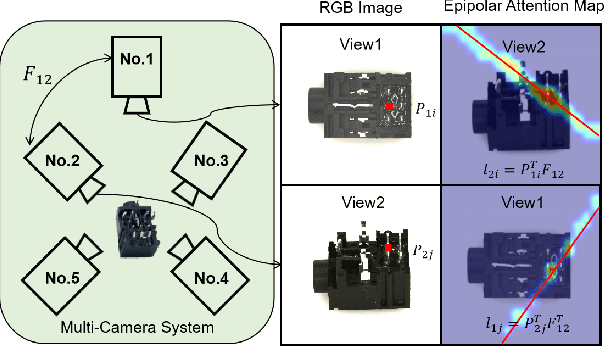
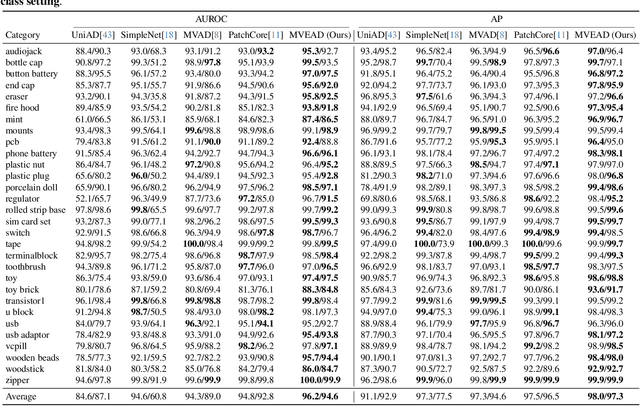

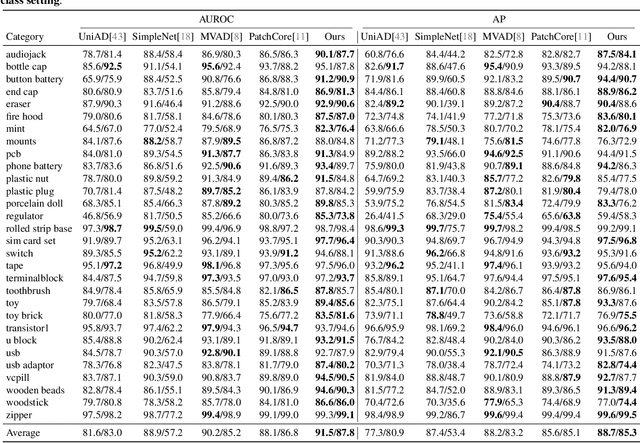
Abstract:Multi-camera systems provide richer contextual information for industrial anomaly detection. However, traditional methods process each view independently, disregarding the complementary information across viewpoints. Existing multi-view anomaly detection approaches typically employ data-driven cross-view attention for feature fusion but fail to leverage the unique geometric properties of multi-camera setups. In this work, we introduce an epipolar geometry-constrained attention module to guide cross-view fusion, ensuring more effective information aggregation. To further enhance the potential of cross-view attention, we propose a pretraining strategy inspired by memory bank-based anomaly detection. This approach encourages normal feature representations to form multiple local clusters and incorporate multi-view aware negative sample synthesis to regularize pretraining. We demonstrate that our epipolar guided multi-view anomaly detection framework outperforms existing methods on the state-of-the-art multi-view anomaly detection dataset.
Ambient Backscatter Communication in LTE Uplink Sounding Reference Signal
Jan 19, 2025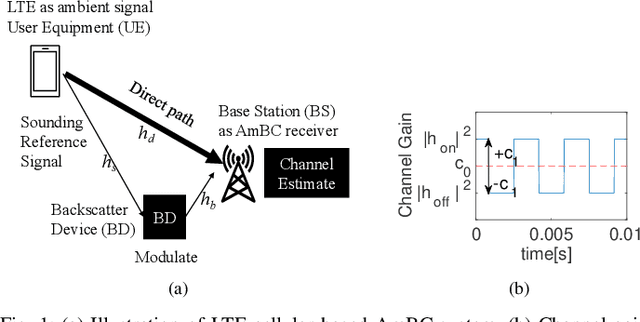
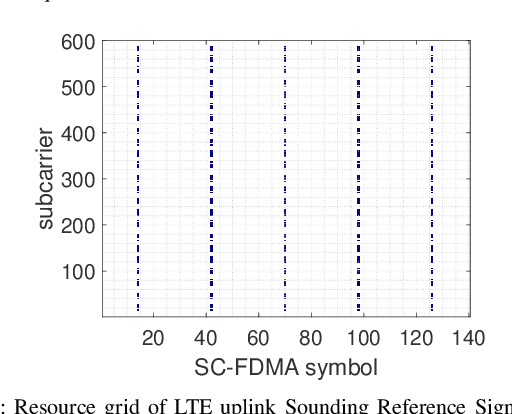
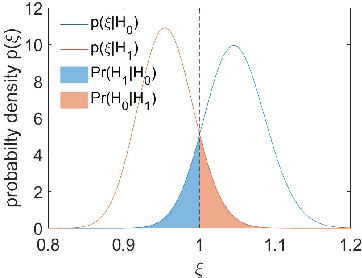
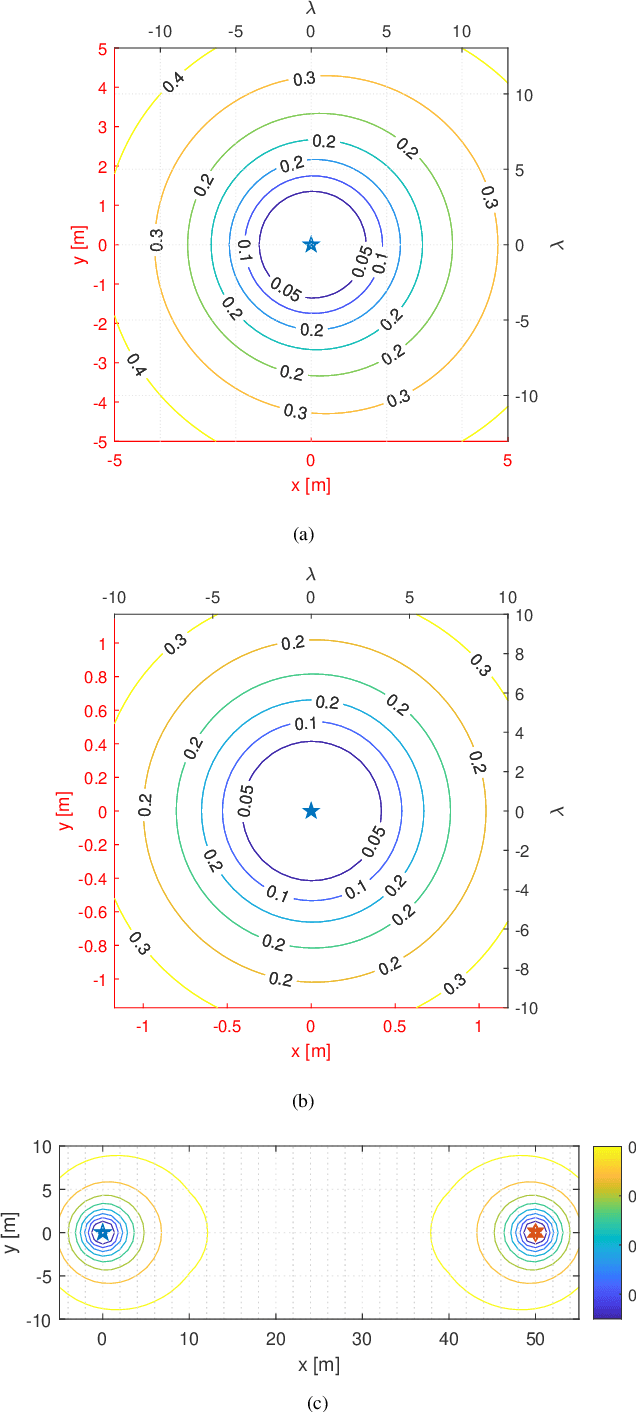
Abstract:Ambient Internet of Things (AIoT), recently standardized by the 3rd Generation Partnership Project (3GPP), demands a low-power wide-area communication solution that operates several orders of magnitude below the power requirements of existing 3GPP specifications. Ambient backscatter communication (AmBC) is considered as a competitive potential technique by harvesting energy from the ambient RF signal. This paper considers a symbiotic AmBC into Long Term Evolution (LTE) cellular system uplink. Leveraging by LTE uplink channel estimation ability, AIoT conveys its own message to Base Station (BS) by modulating backscatter path. We explore the detector design, analyze the error performance of the proposed scheme, provide exact expression and its Guassian approximation for the error probability. We corroborate the receiver error performance by Monte Carlo simulation. Analysis of communication range reveals AmBC achieves a reasonable BER of order of magnitude $10^{-2}$ within four times wavelength reading distance. In addition, a AmBC prototype in LTE uplink confirms the its feasibility. The over-the-air experiment results validate theoretical analysis. Hence, the proposed AmBC approach enables AIoT deployment with minimal changes to the LTE system.
AsymRnR: Video Diffusion Transformers Acceleration with Asymmetric Reduction and Restoration
Dec 16, 2024Abstract:Video Diffusion Transformers (DiTs) have demonstrated significant potential for generating high-fidelity videos but are computationally intensive. Existing acceleration methods include distillation, which requires costly retraining, and feature caching, which is highly sensitive to network architecture. Recent token reduction methods are training-free and architecture-agnostic, offering greater flexibility and wider applicability. However, they enforce the same sequence length across different components, constraining their acceleration potential. We observe that intra-sequence redundancy in video DiTs varies across features, blocks, and denoising timesteps. Building on this observation, we propose Asymmetric Reduction and Restoration (AsymRnR), a training-free approach to accelerate video DiTs. It offers a flexible and adaptive strategy that reduces the number of tokens based on their redundancy to enhance both acceleration and generation quality. We further propose matching cache to facilitate faster processing. Integrated into state-of-the-art video DiTs, AsymRnR achieves a superior speedup without compromising the quality.
SPAgent: Adaptive Task Decomposition and Model Selection for General Video Generation and Editing
Nov 28, 2024
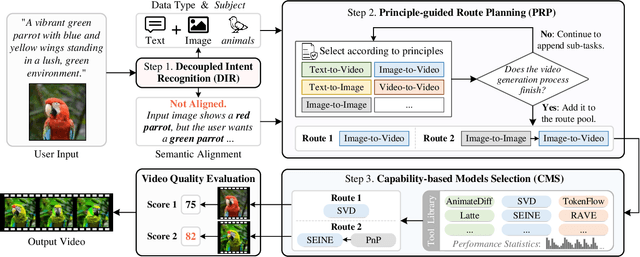

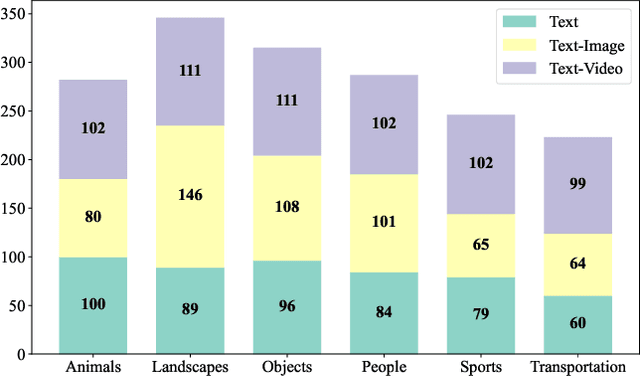
Abstract:While open-source video generation and editing models have made significant progress, individual models are typically limited to specific tasks, failing to meet the diverse needs of users. Effectively coordinating these models can unlock a wide range of video generation and editing capabilities. However, manual coordination is complex and time-consuming, requiring users to deeply understand task requirements and possess comprehensive knowledge of each model's performance, applicability, and limitations, thereby increasing the barrier to entry. To address these challenges, we propose a novel video generation and editing system powered by our Semantic Planning Agent (SPAgent). SPAgent bridges the gap between diverse user intents and the effective utilization of existing generative models, enhancing the adaptability, efficiency, and overall quality of video generation and editing. Specifically, the SPAgent assembles a tool library integrating state-of-the-art open-source image and video generation and editing models as tools. After fine-tuning on our manually annotated dataset, SPAgent can automatically coordinate the tools for video generation and editing, through our novelly designed three-step framework: (1) decoupled intent recognition, (2) principle-guided route planning, and (3) capability-based execution model selection. Additionally, we enhance the SPAgent's video quality evaluation capability, enabling it to autonomously assess and incorporate new video generation and editing models into its tool library without human intervention. Experimental results demonstrate that the SPAgent effectively coordinates models to generate or edit videos, highlighting its versatility and adaptability across various video tasks.
 Add to Chrome
Add to Chrome Add to Firefox
Add to Firefox Add to Edge
Add to Edge